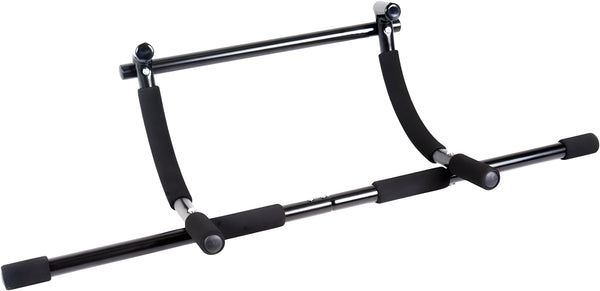Your Cart is Empty
June 09, 2023 4 min read
Pull ups are one of the most effective exercises to build upper body strength, tone your back, and even improve your posture. They can be done in a variety of ways, and there are several different pull up progressions that you can use to level up and get better results.
Shop The Collection: Pull Up BarsIn this article, we'll take a look at how to progress from basic pullups to more advanced versions. We'll also discuss how to incorporate pullups into your regular workout routine, and what type of equipment you'll need to make sure you're doing them correctly. By the end of this article, you'll know exactly how to level up your pullup game.
 Shop The Gear: CAP Barbell Xtreme Doorway Pull Up Bar, $27.99 USD
Shop The Gear: CAP Barbell Xtreme Doorway Pull Up Bar, $27.99 USD
A pull-up is an exercise in which you hang from a bar and pull yourself up until your chin passes the bar. It's a compound exercise that works several muscles in your upper body, including your back, shoulders, biceps, and triceps. The pull-up is a great way to build strength and muscle mass, and it can also help to improve your posture.
The traditional version of the pull-up requires you to use an overhead bar. You can also use a Smith machine or a TRX suspension trainer if you don't have access to an overhead bar. While the traditional pull-up is the most effective version, there are several variations that you can use to make the exercise easier or harder depending on your fitness level.
There are several types of pull up progressions that you can use to increase the difficulty of the exercise. These progressions include:
When doing pull up progressions, you'll need certain pieces of equipment to ensure you're performing the moves safely and correctly. This includes:
Here are some tips for incorporating pull up progressions into your regular workout routine:
Pull ups are a great exercise for building upper body strength, toning your back, and improving your posture. There are several different pull up progressions that you can use to level up and see better results. With the right equipment and proper form, you can incorporate pull up progressions into your regular workout routine and take your fitness to the next level.
Shipping Protection gives you peace of mind while saving you time and money.
Shipping Protection provides coverage for eligible orders that are lost or damaged in transit, or stolen after delivery has been confirmed by the carrier. MAGMA Fitness, through its partners, administers the protection program and may receive compensation for these services. Coverage is subject to the terms, conditions, and exclusions outlined in our Shipping Protection Terms & Conditions.